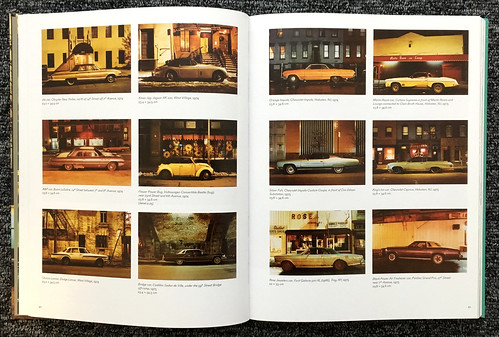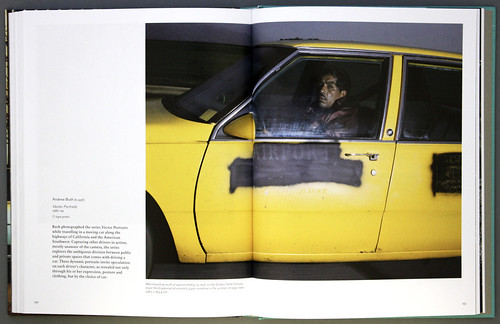Tuesday, 5:00pm
19 November 2019
Four-wheeled dreams
Loose Joints
Lewis Chaplin
Langdon Clay
Gordon Crocker
Rosalind Fox Solomon
Victor Landweber
Andrew Bush
Photography
Critique / Photography
A new book of photographs of cars fails to acknowledge the bigger picture. Photo Critique by Rick Poynor

Photo Critique by Rick Poynor, written exclusively for Eye magazine.
A year ago, to coincide with the opening of its Photography Centre, the V&A launched a new series of books, the V&A Photography Library, in partnership with Thames & Hudson. The idea is to focus on photographic themes that can be traced through images in the museum’s collection, starting with cameraless photography and photographic fictions. The two latest titles turn their attention to specific types of subject matter: trees and cars. The books are enticingly designed by Lewis Chaplin at Loose Joints, and the title of Autofocus: The Car in Photography, plus a rapid survey of the contents, was enough to make this an instant sale when I chanced upon the book in the V&A’s shop. But the survey is not quite as it seemed.
Langdon Clay, Cars series, 1974-75.
Top. Gordon Crocker, Couple in an open top car, ca. 1934.
All pictures taken from Autofocus: The Car in Photography (2019) by Marta Weiss, published by Thames & Hudson in association with the V&A.

For a determined and perfectly contented life-long non-driver, I confess (and not for the first time) to a deeply ambivalent though abiding fascination with cars, with certain aspects of car culture, and with the car’s possibilities as a subject for making images, whether moving or still. It is undeniably the case that cars, as vehicles of both utility and desire, provide telling insights into what propelled and compelled human beings in the modern era.
In one of Autofocus’s most indicative images – a close-up produced for advertising purposes by Gordon Crocker in the mid-1930s – a couple take a pleasure drive in an open-topped car. The woman throws back her head in a state of beatific satisfaction as her partner holds the steering wheel, their faces glowing with ethereal light. There is nothing else in the image other than the clouds that frame their heads and the picture is angled as though the vehicle is gliding up into the air. This seductive tableau shows every sign of being constructed in a studio. Far from driving anywhere on a real road, the models were performing a dream of ecstatically unfettered mobility to fill viewers with envy and make them want to buy a car. Advertising is still peddling the same fantasy today and if all the other motorists also inveigled by the promise of freedom would only get out of the way, perhaps it might even be true.
Unknown photographer. On the ascent to the Simplon Pass, from ‘Paul’ album 4, 1937.

Thirty years later Harper’s Bazaar asked Lee Friedlander to photograph new cars that would be launched the following year. His pictures are so casual as to seem almost disdainful. Instead of glamorising the cars he treats them as incidental features, obscured by piles of tyres and noisy commercial signs, or seen as a reflection in a cluttered store window. This does not come across as a critique of the car so much as a recognition of its omnipresence and ordinariness. As early as 1908, in pictures of Derby Day, parked cars form a backdrop for outdoor socialising. Henri Cartier-Bresson photographs a picnic beside the family car in a farming community in rural Georgia. Ordinary drivers and celebrities alike pose with their vehicles; people lean on them, sit on them and pause for a photo while filling up the tank. In one of the book’s strangest scenes, Karen O’Hearn wraps herself in fabric and contrives a self-portrait next to a car similarly concealed by a cover, an image more sympathetic and humorous than kinky.
Rosalind Fox Solomon, Traffic, Calcutta, 1982.

Autofocus has many great photographs, but it is unsatisfyingly uncertain in focus. It purports to be an ‘introduction’ to the subject, imagining an entry-level audience seeking this kind of visual survey that somehow hasn’t noticed cars ‘are a ubiquitous aspect of modern life’. In her opening paragraph, Marta Weiss, senior curator of photographs at the V&A, declares that the volume is not about cars or about photographs of cars, it is a ‘book about photographs with cars in them’, as though a car had no more meaning than a dining chair or a coffee cup.
Thankfully, that is manifestly not the case with the most arresting of these pictures, which are always in some way about car lovers’ obsessive, emotionally complex relationships with mobile chambers that many consider a four-wheeled extension of home. Andrew Bush’s pictures of speeding drivers symbiotically fused with their machines are an incredibly intense form of portraiture. Even a city street largely empty of vehicles, as in Roger Mayne’s Southam Street pictures from the 1950s, tells us something about the way the car would come to colonise our cities and suburbs and deprive children of crucial safe public spaces to play in.
David Goldblatt, Playground, Chiawelo, Soweto, 1972. Right. Victor Landweber, S. N. Ward and Son Mobil Service, Pasadena, CA, from the portfolio American Roads, 1978, printed 1982.

There is little sense in this collection of the environmental and social damage wrought by cars, yet the photos in the poet Heathcote Williams’s Autogeddon (1991) made the point years ago. Autofocus features only one picture of a wreck resulting from a collision. Every year, according to the World Health Organization, road traffic accidents cause around 1.35 million deaths worldwide. Books such as news photographer Mell Kilpatrick’s Car Crashes and Other Sad Stories (2000), a grisly and truly eye-opening collection of 1940s and 1950s photos of crash sites, and design critic Stephen Bayley’s Death Drive (2016), about fatal celebrity car crashes, provide an essential corrective.
Weirdly, Autofocus closes with a run of vintage pictures of children play-driving miniature autos followed by a carefree young woman ‘ready to ride off at speed in an open-topped car’ in the 1920s – irony apparently unintended. At a time when the problems of our street-choking car dependency are all too apparent this is a curiously limited and unheeding view for a national institution to promulgate.
Rick Poynor writer, Eye founder, Professor of Design and Visual Culture, University of Reading
Andrew Bush. Man travelling south at approximately 73 mph, on the Golden State freeway (near the Grapevine) at around 5:31pm sometime in the summer of 1994, 1994. From Bush’s series Vector Portraits, 1989-94.

Eye is the world’s most beautiful and collectable graphic design journal, published quarterly for professional designers, students and anyone interested in critical, informed writing about graphic design and visual culture. It is available from all good design bookshops and online at the Eye shop, where you can buy subscriptions and single issues.